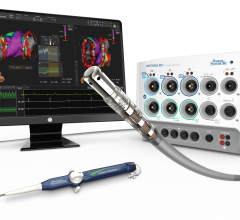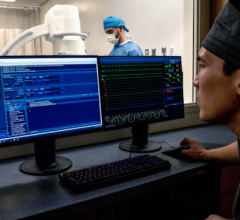Cardiva Medical Inc. announced that the U.S. Food and Drug Administration (FDA) has granted Premarket Approval (PMA) for the Vascade Vascular Closure System (VCS). Clinical data from a prospective, multi-center, randomized 420 patient trial demonstrated that the Vascade VCS is clinically and statistically superior in both safety and efficacy compared to manual compression, the gold standard for vascular closure for patients undergoing percutaneous procedures through the femoral artery.
Performing heart surgery on the same day as angiography is now confirmed as a risk factor for acute kidney injury (AKI), and hospital policy limiting the practice for elective cardiac surgery has significantly reduced the rate of AKI, according to a study published in the February 2013 issue of The Annals of Thoracic Surgery.
This short cine loop shows a 3-D/4-D transesophegeal echo (TEE) view of a transcatheter Amplatzer closure device used to ...
Providing exceptional cardiovascular care for patients to achieve the best possible outcomes is the number one goal for ...
Insight Imaging announced it has expanded its fleet of mobile imaging units to include those previously operated by GE Mobile Interim Solutions (MIS), a unit of GE Capital. Insight Imaging signed an agreement with GE Healthcare to become the preferred provider for GE Healthcare customers’ interim solutions and mobile imaging needs.
GE Healthcare announced two new software packages for advanced analysis of cardiovascular magnetic resonance (MR) images: CardiacVX and MR VesselIQ Xpress. Both CardiacVX and MR VesselIQ Xpress were featured in the GE Healthcare booth at the annual meeting of the Society for Cardiac Magnetic Resonance (SCMR) on Feb. 1-2, 2013, in San Francisco, Calif.

The Centers for Medicare and Medicaid Services (CMS) announced that more than 500 organizations will begin participating in the Bundled Payments for Care Improvement initiative. Through this new initiative, made possible by the Affordable Care Act, CMS will test how bundling payments for episodes of care can result in more coordinated care for beneficiaries and lower costs for Medicare.
Cardiac positron emission tomography (PET) is growing in popularity among cardiologists because it provides the ability ...
Patients want to play an active role in managing their healthcare — and online access to medical records is an important first step. This concept is also a requirement in Stage 2 Meaningul Use requirements.

The Centers for Medicare and Medicaid Services (CMS) announced a final rule for the Sunshine Act on Feb. 1 that will increase public disclosure of financial relationships between drug and device manufacturers and physicians and teaching hospitals.

A new computed tomography (CT) scanner substantially reduces potentially harmful radiation while still improving overall image quality. National Institutes of Health (NIH) researchers, along with engineers at Toshiba Medical Systems, worked on the scanner. An analysis of data on 107 patients undergoing heart scans found that radiation exposure was reduced by as much as 95 percent compared to the range of current machines, while the resulting images showed less blurriness, reduced graininess and greater visibility of fine details.
When performing radiofrequency (RF) ablation to treat cardiac arrhythmia, medical professionals must balance the safety ...
As a member of the Heart Rhythm Society, Andrea Russo, M.D., had grown accustomed to searching in vain for a cutting-edge solution to solve the traditional business issues associated with electrophysiology (EP) — silos of information; manual, paper-intensive processes; inaccurate and outdated patient data; and lengthy turnaround times for reports to reach referring physicians.

Catheter-based thrombectomy systems are increasingly being used to remove blood clots from vessels inside the body, often as an adjunct therapy to systemic pharmaceutical thrombolytics. These systems are used in veins, as in the case of deep vein thrombosis (DVT), and in arteries, in the case of pulmonary embolism (PE), ST-elevated myocardial infarction (STEMI) and ischemic stroke. The systems can also quickly clear dialysis arteriovenous grafts, which are prone to thrombus formation.

The interventional cardiology market includes, but is not limited to, drug-eluting stents, bare-metal stents, percutaneous transluminal coronary angioplasty (PTCA) and cutting balloon catheters. Although this market is growing overall, some segments are experiencing low negative growth and even dropping in value. Currently there are a few top competitors that hope to gain market share by bringing bioabsorbable stents into the U.S market.
Change Healthcare Cardiology Hemodynamics is an integrated hemodynamic monitoring system for monitoring vital signs and ...
My job as editor of DAIC is to help readers keep tabs on the latest in cardiovascular technology and trends. With collaboration from my Editorial Advisory Board, we developed a 2013 editorial calendar based on several predictions on what will be the key game-changing technologies. These were determined from observations at numerous cardiology meetings we attended and from needs or trends members of the board have seen in their own practices. Here are our top predictions:
Biotronik recently launched its 3Flow Aspiration Catheter in Europe. The catheter is specifically designed to facilitate quick and accurate thrombus aspiration, complementing Biotronik’s already broad coronary vascular intervention (CVI) portfolio.
Few issues are more important to the American College of Cardiology (ACC) and the American Heart Association (AHA) than translating the best available scientific evidence into clinical practice guidelines that can be used by healthcare professionals to improve patient outcomes and the quality of cardiovascular care. This is evidenced by the 17 clinical practice guideline topics — and many more updates — the organizations have jointly developed and published since the early 1980s through a highly robust process and methodology that continues to evolve.


 February 07, 2013
February 07, 2013








